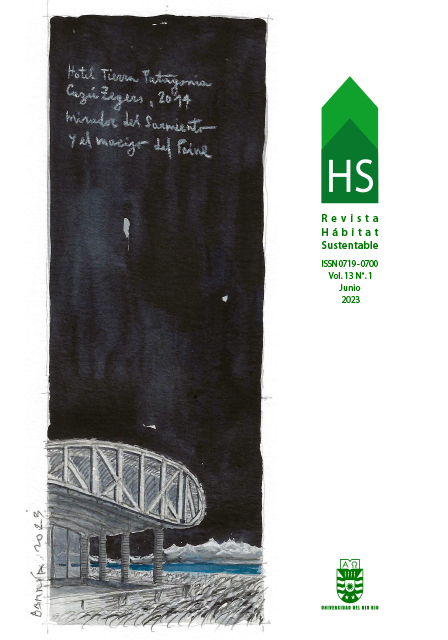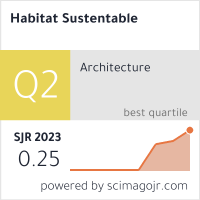Aportes de la metodología de aula invertida en el proceso de enseñanza-aprendizaje de la arquitectura bioclimática
DOI:
https://doi.org/10.22320/07190700.2023.13.01.08Palabras clave:
arquitectura bioclimática, educación, aula invertida, proyectos, arquitectura vernácula, arquitectura sustentableResumen
La educación se ha transformado debido a las tecnologías. Por lo cual, más que compartir el conocimiento, se busca promover la creatividad desde herramientas y métodos. El objetivo del presente documento es analizar la idoneidad del aula invertida en el proceso de enseñanza-aprendizaje de la arquitectura bioclimática en contexto de pandemia o enseñanza tradicional presencial. La metodología tiene un enfoque cualitativo, diseño no experimental, y estudio exploratorio. Los resultados confirman que los alumnos dedujeron los conocimientos teóricos y las competencias que habrían recibido de manera lineal en el aula tradicional. Como conclusión, se plantea que la diferencia de esta práctica docente respecto a la tradicional estuvo en hacer que lo teórico deviniera de lo práctico, accionando un proceso de transposición didáctica que no sólo simplificó los saberes, sino que se apoyó en generar transversalidades desde las variables que integran el proceso de aprendizaje.
Descargas
Citas
AGUILERA-RUIZ, C., MANZANO-LEÓN, A., MARTÍNEZ-MORENO, I., LOZANO-SEGURA, M. DEL C. & YANICELLI, C. C. (2017). El modelo flipped classroom. International Journal of Developmental and Educational Psychology, 4(1), 261-266. Recuperado de: https://revista.infad.eu/index.php/IJODAEP/article/view/1055/931
ALBARELLO, F. (2016). El ecosistema digital de los jóvenes universitarios. En: J.C. Durand, Á. V. Corengia, F. T. Daura (directores) & M. S. Urrutia (Coordinadora). Aprender a enseñar: el desafío de la formación docente inicial y continua. Actas de las VII Jornadas Académicas de la Escuela de Educación de la Universidad Austral, Valdivia, Chile. Recuperado de: https://www.teseopress.com/formaciondocente
ALMONTE, S., CADIMA, P., YANNAS, S., DE HERDE, A., RIEMER, H., CANGELLI, E., LÓPEZ DE ASIAIN, M. & HORVATH, S. (2012). Educate! Sustainable environmental design in architectural education and practice. [Artículo]. PLEA2012 - 28th Conference, Opportunities, Limits & Needs Towards an environmentally responsible architecture., Lima, Perú. Recuperado de: https://plea-arch.org/ARCHIVE/websites/2012/files/T09-20120129-0022.pdf
BERENGUER, C. (2016). Acerca de la utilidad del aula invertida o flipped classroom. En: M. Tortosa, S. Grau & J. Álvarez (Ed.), XIV Jornadas de redes de investigación en docencia universitaria. Investigación, innovación y enseñanza universitaria: enfoques pluridisciplinares. Alicante, España, 1466-1480. Recuperado de: http://rua.ua.es/dspace/handle/10045/57093
CAMPO BAEZA, A. (2018). Quiero ser arquitecto. Para los que sueñan y luego quieren construir esos sueños. Diseño editorial. España. Recuperado de: https://core.ac.uk/download/pdf/148670238.pdf
CORNELIS-JANSSEN, C. H. (2020). El aula invertida en tiempos del COVID-19. Educación química, 31(5), 173-178. DOI: https://doi.org/10.22201/fq.18708404e.2020.5.77288
DAURA, F. & BARNEY, M. C. (2016). El desafie de enseñar a la generacion net En: J. C. Durand, Á. V. Corengia, F. T. Daura (Directores) & M. S. Urrutia (Coordinadora) (2016) Aprender a enseñar: el desafío de la formación docente inicial y continua. Actas de las VII Jornadas Académicas de la Escuela de Educación de la Universidad Austral, Valdivia, Chile. Recuperado de: https://www.teseopress.com/formaciondocente
GIVONI, B. (1969). Man, climate, and architecture. Elsevier.
GODINO, J. D. (2013). Indicadores de la idoneidad didáctica de procesos de enseñanza y aprendizaje de las matemáticas. Cuadernos de Investigación y Formación en Educación Matemática, (11), 111-132. Recuperado de: https://revistas.ucr.ac.cr/index.php/cifem/article/view/14720
GODINO, J. D., GIACOMENE, B., BATANERO, C. & FONT, V. (2017). Enfoque Ontosemiótico de los Conocimientos y Competencias del Profesor de Matemáticas. Bolema, Rio Claro, 31(57), 90-113. DOI: http://dx.doi.org/10.1590/1980-4415v31n57a05
GONZÁLEZ-SANMARTÍN, V. A. & YANACALLO-PILCO, W. V. (2020). Aprender haciendo: Aplicación de la metodología por ambientes de aprendizaje. Polo del Conocimiento, 5(7), 188-2008. Recuperado de: https://polodelconocimiento.com/ojs/index.php/es/article/view/1503
JANSSEN, C. H. C. (2020). El aula invertida en tiempos del COVID-19. Educación Química, 31(5), 173-178. DOI: https://doi.org/10.22201/fq.18708404e.2020.5.77288
LÓPEZ-GUTIÉRREZ, J. C. & PÉREZ-ONES, I. (2022). Docencia universitaria y transposición didáctica. Estudio de percepción. Revista Chakiñan de Ciencias Sociales y Humanidades, (16), 24-34. DOI: https://doi.org/10.37135/chk.002.16.01
NEILA-GONZÁLEZ, J. & BEDOYA-FRUTOS, C. (1997). Técnicas arquitectónicas y constructivas de acondicionamiento ambiental. Munilla-Lería.
OLGYAY, V. (1963). Design with Climate Bioclimatic Approach to Architectural Regionalism. University Press.
PERILLA GRANADOS, J. S. (2018). Las nuevas generaciones como un reto para la educación actual. Universidad Sergio Arboleda. Bogotá, Colombia. Recuperado de: https://repository.usergioarboleda.edu.co/bitstream/handle/11232/1222/Nuevas%20generaciones.pdf?sequence=5
PHILOKYPROU, M. (2011). Teaching vernacular architecture and rehabilitation in relation to bioclimatic design elements. In Architecture & Sustainable Development (vol. 1): 27th International Conference on Passive and Low Energy Architecture (Vol. 1, p. 89). Presses univ. de Louvain.
RESTREPO BOTERO, C. (2013). Inclusión de la dimensión bioclimática en la enseñanza de la arquitectura en un marco sostenible. Caso de estudio programa de arquitectura de la Universidad Católica de manizales: Integración de los temás bioclimáticos y energético ambientales en un marco sostenible en la totalidad del currículo académico [Tesis de maestría. Universidad Internacional de Andalucía]. Recuperado de: https://dspace.unia.es/bitstream/handle/10334/2510/0450_Restrepo.pdf?sequence=1&isAllowed=y
SALDARRIAGA, A. (1996). Aprender arquitectura. Manual de supervivencia.. Editorial Corona.
SORIANO-HERNÁNDEZ, E. & AGUILAR-ESPINOSA, M. G. (2018). Nuevas generaciones, cambio de estrategias de aprendizaje. Jóvenes en la Ciencia Revista de divulgación Científica, 4(1), 1983-1987. Recuperado de: https://www.jovenesenlaciencia.ugto.mx/index.php/jovenesenlaciencia/article/view/2916
UNESCO. (2019). Marco de aplicación de la Educación para el Desarrollo Sostenible (EDS) después de 2019. Conferencia General, 40th, [1185]. Recuperado de: https://unesdoc.unesco.org/ark:/48223/pf0000370215_spa 08/05/2021
VIDAL-LEDO, M. J., MARTÍNEZ-HERNÁNDEZ, G., NOLLA-CAO, N. & VIALART-VIDAL, M. N. (2015). Entornos personales de Aprendizaje. Educación Médica Superior. 29(4). Recuperado de: https://ems.sld.cu/index.php/ems/article/view/726/314
WILLINER, B. (2021). La clase invertida a través de tareas: Una experiencia durante el periodo de aislamiento por COVID-19 en carreras de ingeniería. Revista Iberoamericana de Tecnología en Educación y Educación en Tecnología, (28), 48-55. DOI: https://doi.org/10.24215/18509959.28.e6
Descargas
Publicado
Cómo citar
Número
Sección
Licencia
Derechos de autor 2023 Alejandro Guerrero-Torrenegra, María Verónica Machado-Penso, Jorge Alberto Aldea-Lopez, Nelsy Dufay Londoño-Bermúdez

Esta obra está bajo una licencia internacional Creative Commons Atribución-CompartirIgual 4.0.
El contenido de los artículos que se publican en cada número de Hábitat Sustentable, es responsabilidad exclusiva de los autores y no representan necesariamente el pensamiento ni comprometen la opinión de la Universidad del Bío-Bío.
Los autores/as conservarán sus derechos de autor y garantizarán a la revista el derecho de primera publicación de su obra, el cuál estará simultáneamente sujeto a la Licencia de Reconocimiento de Creative Commons CC BY-SA que permite a otros compartir-copiar, transformar o crear nuevo material a partir de esta obra con fines no comerciales, siempre y cuando se reconozcan la autoría y la primera publicación en esta revista, y sus nuevas creaciones estén bajo una licencia con los mismos términos.











 Programa de Información Científica/Concurso Fondos de Publicación de Revistas Científicas 2018/ Proyecto Mejoramiento de Visibilidad de Revistas UBB (Código:FP180007)
Programa de Información Científica/Concurso Fondos de Publicación de Revistas Científicas 2018/ Proyecto Mejoramiento de Visibilidad de Revistas UBB (Código:FP180007) 





